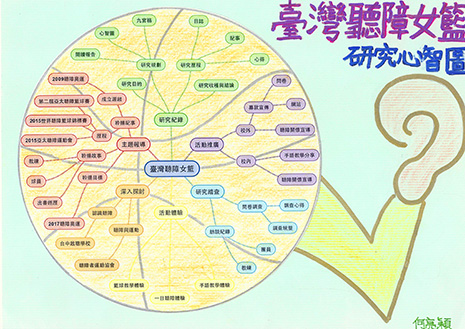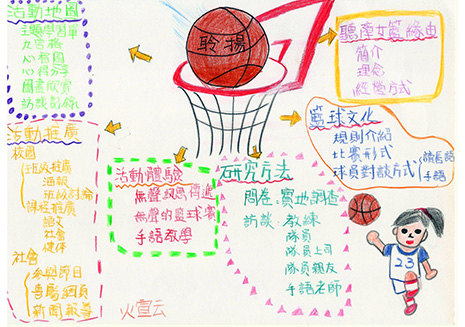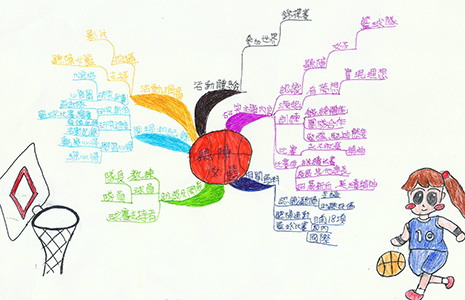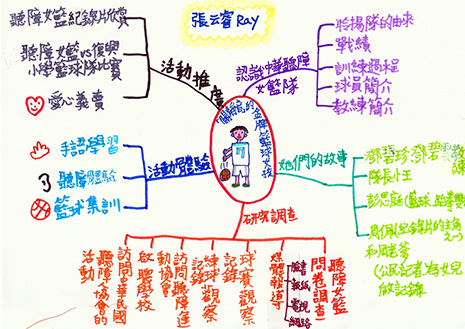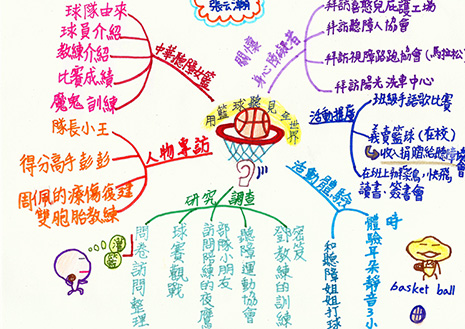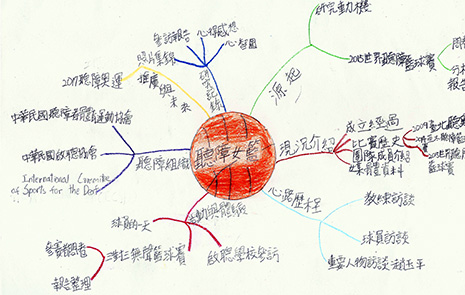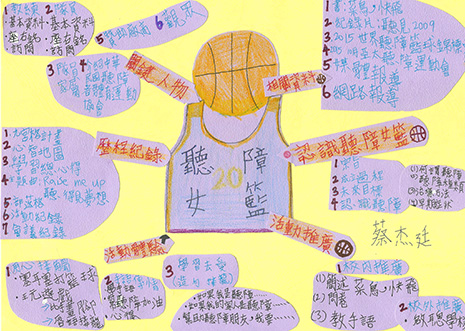 |
|||
 |
2) Mind Maps
Apart from the nine-box matrix, we also learned another more detailed thinking technique which is called "Mind Mapping". Different from the nine-box matrix, the development of a mind map calls for a more specific and well-defined research framework. Therefore, we needed to obtain a certain degree of knowledge on the research topic prior to creating the mind maps. First, I developed a preliminary understanding of the Deaf Women’s Basketball Team by researching relevant information on the Internet and reading their book, "Rookies, Fly Faster". Thanks to the convenience of modern technology, there are all kinds of Mind Map Apps available for free downloads on iPads. With the help of the App, I could adjust and modify my mind map easily. Besides the content of the framework, the presentation design was also important. So I racked my brain hoping to highlight the feature of the Deaf Women’s Basketball Team. Thanks once again to the convenient software, I could arrange the mind map into any shape I want. In the end, I decided to make it into the shape of a basketball bouncing upward, which was inspired from the logo in the book "Rookies, Fly Faster", accompanied by a drawing of the ear. After every member of the group completed his or her mind map, the teacher consolidated our structures and established the research framework for our group. Combining the thoughts of all of us, this framework was not only more comprehensive, but also opened my eyes to different ways of thinking. It was truly a great learning experience.
Mind map is similar to the nine-box matrix. The purpose of mind mapping is to have a clearer understanding of the theme and provides further exploration of the topic. First we decided on our topics - Taiwan Deaf Women's Basketball. Next we wrote down related information about the topic, and expanded our thoughts to complete the mind maps. Just like learning simple sign languages in the extended learning activity can help us to have a better understanding of the communication and inconvenience of the hearing-impaired, the charity sale to promote the books can also help to rise funding for their training and competitions. I think mind mapping is a very practical tool. As long as you understand the usage, you can put disoriented data into distinguished orders, so that it’s clear for all and efficient to find the data you need. And you can implement the plan step by step in accordance.
Mind mapping is to first set up a central theme, then associate the theme with smaller topics, and expand to more specific details. Our theme is "Deaf Women's Basketball Team", which is divided into six smaller topics: history of Deaf Women's Basketball Team, research methods, basketball culture, mind maps, experiential activities, and promotional activities. Then we expand these six topics with associated text and illustrations to complete the mind map. Through the use of mind map, it renders a clear integration of my thoughts about Deaf Women's Basketball. I think mind mapping is really a great tool. It can organize the contents of issues to be explored, and also trigger more thoughts and ideas, and help to put the research content at a glance. It is "half the work, twice the effect". Through participation in this project, I become familiar with the use of mind maps. I believe we can achieve good results.
The teacher and our group members gathered to discuss a theme for our research project. We examined several potential topics, and finally decided on "Deaf Women's Basketball Team". The teacher suggested that we use mind maps to set up the structure for our research framework, which helped me brainstorm and triggered my thoughts. I used "Deaf Women's Basketball Team" as the central theme, and extended into six categories for exploring, which were "research topics contents", "related data", "experiential activities", "promotional activities", "interviews and questionnaires", "process and records". I used six different colors: pink, dark blue, black, orange, green, and blue, to distinguish the six different categories, which were further extended for continual exploration of the content. From this assignment, I learned to use mind maps to show my thought process on this topic.
I named the research about Deaf Women's Basketball Team: "Muted Gold Medal Basketball Girls", because they are hearing-impaired and it’s like a cell phone being put on mute. But this deficiency made them even more focused and determined to win. At last they became the champion for the 2014 DIBF Asia Pacific Cup last year! I hope their story could be seen and heard by more people through the website we produce. As a player of the Fuhsing Elementary School basketball team myself, I hope to exchange skills and learn from the big sisters of Deaf Women’s Basketball Team. I also want to experience and learn sign language, to understand the inconvenience of people with disabilities. I hope we can hold a charity bazaar on campus to help more hearing-impaired persons in need.
My mind map is entitled "Hear the whole world with basketball", because the Chinese Taipei Deaf Basketball players cannot hear well with their ears, but they keep on practicing hard. They transformed from a mismatched team to the winner of the Asia-Pacific Cup Gold Medal, and let the world see them shine. Other than interview the coaches and players who I admire very much, I hope we can organize book club or book signing in my class for the book "Rookies, Fly Faster", which was published by the Deaf Women's Basketball Team. I also want to experience silence for three hours, just like the "30 Hour Famine", to comprehend the inconvenience and hardship of deaf people. And if possible, hold a "sign language song contest" in school which would be very interesting and meaningful.
Mind maps can help us understand many things, and makes it easy to read and understand the entire structure. I use mind map to outline the research. It allows me to know what to do next, which is a very effective tool. Since this is the first time I create a mind map, I am not very familiar with the usage. My idea is to put the to-do list of the project into a chart, then turn it into a mind map. I categorize into seven main items: origin, current status, process, activities and experiences, promotion and outlook, deaf organizations and research records. I then further consider the things we can do for each item. After consolidating everyone’s mind map, it will then become the framework for our research project.
As a start, I researched about deaf women's basketball on the Internet. Then I carefully read through all the information. I organized the data into six parts, which were: "About deaf women's basketball team", "Key persons", "Promotional activities", "Experiential activities", "Related Information", and "Process and records". We need to first gather a lot of information about deaf women's basketball. If the data is insufficient, we will then setup interviews to obtain first-hand information. I will also introduce the book and documentary film related to Deaf Women's Basketball. It is tough being a hearing-impaired player, because it is difficult to hear the instructions. In order to be more empathetic, I'll use earplugs and play a game with the hearing-impaired women's basketball players and learn about the inconvenience. I will also learn sign language to root for the deaf athletes. Finally, government and private sectors are not as supportive of deaf basketball tournaments as they could. There were times when the players could not participate in the competitions due to insufficient funding. I hope our project will help to promote so that more people will know about deaf basketball and the problems they encounter. The goal is for everyone to lend a helping hand so that they can participate in tournaments. Working on a research project is tough yet interesting. I will document the process step by step for a perfect conclusion. |
||||||||||||||||||||||||||||||||||||||||||||||
|

